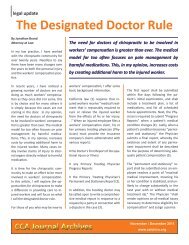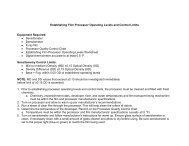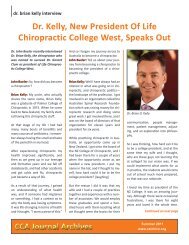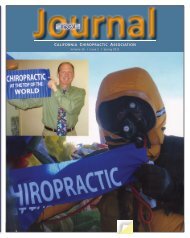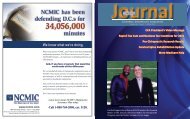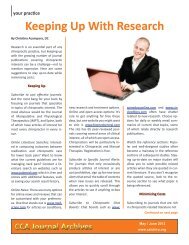Membership Directory - CCA Journal magazine
Membership Directory - CCA Journal magazine
Membership Directory - CCA Journal magazine
You also want an ePaper? Increase the reach of your titles
YUMPU automatically turns print PDFs into web optimized ePapers that Google loves.
code of ethics<br />
code of ethics<br />
Suggested Sanction(s)/Directive(s): 2, B<br />
2.04 Use of Assessment in General and With Special Populations<br />
(a) Doctors of Chiropractic who perform treatment or administer, score, interpret,<br />
or use assessment techniques are familiar with the reliability, validation,<br />
and related standardization or outcome studies of, and proper applications and<br />
uses of, the techniques they use.<br />
Suggested Sanction(s)/Directive(s): 2, B<br />
(b) Doctors of Chiropractic recognize limits to the certainty with which diagnoses,<br />
judgments, or predictions can be made about individuals.<br />
Suggested Sanction(s)/Directive(s): 1, A<br />
(c) Doctors of Chiropractic attempt to identify situations in which particular<br />
treatments or assessment techniques or norms may not be applicable or may<br />
require adjustment in administration or interpretation because of factors such<br />
as individuals gender, age, race, ethnicity, national origin, religion, sexual orientation,<br />
disability, language, or socio-economic status.<br />
Suggested Sanction(s)/Directive(s): 2, B<br />
2.05 Interpreting Assessment Results<br />
When interpreting assessment results, including automated interpretations,<br />
Doctors of Chiropractic take into account the various test factors and characteristics<br />
of the person being assessed that might affect the judgment of the Doctor<br />
of Chiropractic or reduce the accuracy of their interpretations. They indicate<br />
any significant reservations they have about the accuracy or limitations of their<br />
interpretations.<br />
Suggested Sanction(s)/Directive(s): 1, A<br />
2.06 Unqualified Persons<br />
Doctors of Chiropractic do not promote the use of chiropractic treatment or assessment<br />
techniques by unqualified persons.<br />
Suggested Sanction(s)/Directive(s):<br />
2.07 Obsolete Tests and Outdated Test Results<br />
(a) Doctors of Chiropractic do not base their assessment or treatment decisions or<br />
recommendations on data or test results that are outdated for the current purpose.<br />
Suggested Sanction(s)/Directive(s): 1, A, C<br />
(b) Similarly, Doctors of Chiropractic do not base such decisions or recommendations<br />
on tests and measures that are obsolete and not useful for the current purpose.<br />
Suggested Sanction(s)/Directive(s):<br />
2.08 Test Scoring and Interpretation Services<br />
(a) Doctors of Chiropractic who offer assessment or scoring procedures to other<br />
professionals accurately describe the purpose, norms, validity, reliability, and applications<br />
of the procedures and any special qualifications applicable to their use.<br />
Suggested Sanction(s)/Directive(s): 1, A<br />
(b) Doctors of Chiropractic select scoring and interpretation services (including automated<br />
services) on the basis of evidence of the validity of the program and procedures<br />
as well as on other appropriate considerations.<br />
Suggested Sanction(s)/Directive(s): 1, A, C<br />
(c) Doctors of Chiropractic retain appropriate responsibility for the appropriate<br />
application, interpretation, and use of assessment instruments, whether they<br />
score and interpret such tests themselves or use automated or other services.<br />
Suggested Sanction(s)/Directive(s): 1, A<br />
2.09 Explaining Assessment Results<br />
Unless the nature of the relationship is clearly explained to the person being<br />
assessed in advance and precludes provision of an explanation of results (such<br />
as in some organizational consulting, preemployment or security screening, and<br />
forensic evaluations), Doctors of Chiropractic ensure that an explanation of the<br />
results is provided using language that is reasonably understandable to the person<br />
assessed or to another legally authorized person on behalf of the patient<br />
or client. Regardless of whether the scoring and interpretation are done by the<br />
Doctor of Chiropractic, by assistants, or by automated or other outside services,<br />
Doctors of Chiropractic take reasonable steps to ensure that appropriate explanations<br />
of results are given.<br />
Suggested Sanction(s)/Directive(s): 1, 2, A, C<br />
2.10 Maintaining Test/Assessment Security<br />
Doctors of Chiropractic make reasonable efforts to maintain the integrity and<br />
security of tests and other assessment techniques consistent with law, contractual<br />
obligations, and in a manner that permits compliance with the requirements<br />
of this Code of Ethics.<br />
Suggested Sanction(s)/Directive(s): 1, 2, A, B, C<br />
3. ADVERTISING AND OTHER PUBLIC STATEMENTS<br />
3.01 Definition of Public Statements<br />
Doctors of Chiropractic comply with this Code of Ethics in public statements<br />
relating to their professional services, products, or publications or to the field<br />
of chiropractic. Public statements include but are not limited to paid or unpaid<br />
advertising, brochures, printed matter, directory listings, personal resumes or<br />
curricula vitae, interviews or comments for use in media, statements in legal<br />
proceedings, lectures and public oral presentations, and published materials.<br />
Suggested Sanction(s)/Directive(s): 1, 2, 3, 4, 5, A, B, E<br />
3.02 Statements by Others<br />
(a) Doctors of Chiropractic who engage others to create or place public statements<br />
that promote their professional practice, products, or activities retain<br />
professional responsibility for such statements.<br />
Suggested Sanction(s)/Directive(s): 1, 2, 3, 4, 5, A, B, E<br />
(b) In addition, Doctors of Chiropractic make reasonable efforts to prevent others<br />
whom they do not control (such as employees, publishers, sponsors, organizational<br />
clients, and representative of the print and broadcast media) from making<br />
deceptive statements concerning the practice or professional or scientific<br />
activities of Doctors of Chiropractic.<br />
Suggested Sanction(s)/Directive(s): 1, 2, 3, 4, 5, A, B, C, E<br />
(c) If Doctors of Chiropractic learn of deceptive statements about their work made by<br />
others, Doctors of Chiropractic make reasonable efforts to correct such statements.<br />
Suggested Sanction(s)/Directive(s): 1, 2, 3, 4, 5, A, E<br />
(d) Doctors of Chiropractic do not compensate employees of press, radio, television,<br />
or other communication media in return for publicity in a news item.<br />
Suggested Sanction(s)/Directive(s): 1, 2, 3, 4, 5, A, B, E<br />
(e) A paid advertisement relating to the Doctor of Chiropractic’s activities must<br />
be identified as such, unless it is apparent from the context.<br />
Suggested Sanction(s)/Directive(s): 1, 2, 3, A, B, E<br />
3.03 Avoidance of False or Deceptive Statements<br />
(a) Doctors of Chiropractic do not make public statements that are false, deceptive,<br />
misleading, or fraudulent, either because of what they state, convey, or<br />
suggest or because of what they omit, concerning their research, practice, or<br />
other work activities or those of persons or organizations with which they are<br />
affiliated. As examples (and not in limitation) of this standard, Doctors of Chiropractic<br />
do not make false or deceptive statements concerning (1) their training,<br />
experience, or competence; (2) their academic degrees; (3) their credentials; (4)<br />
their institutional or association affiliations; (5) their services; (6) the scientific<br />
or clinical basis for, or results or degree of success of their services; (7) their<br />
fees; or (8) their publications or research findings.<br />
Suggested Sanction(s)/Directive(s): 1, 2, 3, 4, 5, A, B, E<br />
(b) Doctors of Chiropractic claim as credentials for their chiropractic work, only<br />
degrees that (1) were earned from a regionally accredited educational institution<br />
or (2) were the basis for chiropractic licensure by the State of California.<br />
Suggested Sanction(s)/Directive(s): 1, 2, 3, 4, 5, A, B, E<br />
3.04 Media Presentations<br />
When Doctors of Chiropractic provide advice or comment by means of public<br />
lectures, demonstrations, radio or television programs, prerecorded tapes,<br />
printed articles, mailed material, or other media, they take reasonable precautions<br />
to ensure that (1) the statements are based on appropriate chiropractic<br />
literature and practice, (2) the statements are otherwise consistent with this<br />
Code of Ethics, and (3) the recipients of the information are not encouraged to<br />
infer that a relationship has been established with them personally.<br />
Suggested Sanction(s)/Directive(s): 1, 2, 3, 4, 5, A, B, C, E<br />
4. TREATMENT<br />
4.01 Structuring the Relationship<br />
(a) Doctors of Chiropractic discuss with patients or clients as early as is feasible<br />
in the therapeutic relationship appropriate issues, such as the nature and<br />
anticipated course of treatment, fees, and confidentiality. (See also Standards<br />
1.24, Fees and Financial Arrangements, and 5.01 Discussing the Limits of Confidentiality.)<br />
Suggested Sanction(s)/Directive(s): 1, 2, 3, 4, 5, A, B, E<br />
(b) When the Doctor of Chiropractic’s work with patients or clients will be supervised,<br />
the above discussion includes that fact, and the name of the supervisor,<br />
when the supervisor has legal responsibility for the case.<br />
Suggested Sanction(s)/Directive(s): 1, 2, A<br />
(c) When the treating person is a student intern, the patient or client is informed<br />
of that fact.<br />
Suggested Sanction(s)/Directive(s): 1, 2, A<br />
(d) Doctors of Chiropractic make reasonable efforts to answer patient’s questions<br />
and to avoid apparent misunderstandings about treatment. Whenever<br />
possible, Doctors of Chiropractic provide oral and/or written information, using<br />
language that is reasonably understandable to the patient or client.<br />
Suggested Sanction(s)/Directive(s): 1, 2, A, C<br />
4.02 Informed Consent to Treatment<br />
(a) Doctors of Chiropractic obtain informed consent to treatment or related procedures,<br />
using language that is reasonably understandable to participants. The<br />
content of informed consent will vary depending on many circumstances; however,<br />
informed consent generally implies that the person (1) has the capacity to<br />
consent, (2) has been informed of significant information concerning the procedure,<br />
individual risks and benefits of and alternatives, (3) has freely and without<br />
undue influence expressed consent, and (4) consent has been documented.<br />
Suggested Sanction(s)/Directive(s): 1, 2, 3, 4, 5, A, B, C<br />
(b) When persons are legally incapable of giving informed consent, Doctors of<br />
Chiropractic obtain informed permission from a legally authorized person, if<br />
such substitute consent is permitted by law.<br />
Suggested Sanction(s)/Directive(s): 1, 2, 3, 4, 5, A, B, C<br />
(c) In addition, Doctors of Chiropractic (1) inform those persons who are legally incapable<br />
of giving informed consent about the proposed treatments in a manner<br />
commensurate with the person’s reasoning capacities as can best be determined at<br />
the time, (2) seek their assent to those treatments, and (3) consider such persons<br />
preferences and best interests.<br />
Suggested Sanction(s)/Directive(s): 1, 2, 3, 4, 5, A, B, C<br />
4.03 Couple and Family Relationships<br />
(a) When a Doctor of Chiropractic agrees to provide services to several persons<br />
who have a relationship (such as husband and wife or parents and children), the<br />
Doctor of Chiropractic attempts to clarify at the outset (1) which of the individuals<br />
are patients and (2) the relationship the Doctor of Chiropractic will have with<br />
each person. This clarification includes the role of the Doctor of Chiropractic<br />
and probable uses of the services provided or the information obtained. (See<br />
also Standard 5.01, Discussing the Limits of Confidentiality.)<br />
Suggested Sanction(s)/Directive(s): 1, 2, 3, 4, 5, A, B, C<br />
(b) As soon as it becomes apparent that the Doctor of Chiropractic may be called<br />
upon to perform potentially conflicting roles (witness for one party in a divorce<br />
proceeding), the Doctor of Chiropractic attempts to clarify and adjust, or withdraw<br />
from roles appropriately. (See also Standard 7.03, Clarification of Role,<br />
under Forensic Activities.)<br />
Suggested Sanction(s)/Directive(s): 1, 2, 3, 4, 5, A, B, C<br />
4.04 Providing Chiropractic Services to Those Served by Others<br />
In deciding whether to offer to provide services to those already receiving<br />
chiropractic services elsewhere, Doctors of Chiropractic carefully consider the<br />
treatment issues and the potential patient’s welfare. The Doctor of Chiropractic<br />
discusses these issues with the patient or client, or another legally authorized<br />
person on behalf of the patient, in order to minimize the risk of confusion and<br />
conflict, consults with other service providers when appropriate, and proceeds<br />
with caution and sensitivity to the therapeutic issues.<br />
Suggested Sanction(s)/Directive(s): 1, 2, 3, 4, 5, A, B<br />
4.05 Sexual Intimacies With Current Patients or Clients<br />
Doctors of Chiropractic do not engage in sexual intimacies with current patients<br />
or clients.<br />
Suggested Sanction(s)/Directive(s): 1, 2, 3, 4, 5, A, B, D<br />
4.06 Sexual Intimacies With Former Patients<br />
(a) Doctors of Chiropractic do not engage in sexual intimacies with a former<br />
patient or client for at least two years after cessation or termination of professional<br />
services or until the patient’s care has been transferred to the practice of<br />
another Doctor of Chiropractic.<br />
Suggested Sanction(s)/Directive(s): 1, 2, 3, 4, 5, A, B, D<br />
(b) Because sexual intimacies with a former patient or client are so potentially<br />
confusing or harmful to the patient or client, and because such intimacies undermine<br />
public confidence in the chiropractic profession and thereby deter the<br />
public’s use of needed services, Doctors of Chiropractic do not engage in sexual<br />
intimacies with former patients or clients even after a two year interval except<br />
in the most unusual circumstances. The Doctor of Chiropractic who engages<br />
in such activity even after the two years following cessation or termination of<br />
treatment bears the burden of demonstrating that there has been no exploitation,<br />
in light of all relevant factors, including (1) the amount of time that has<br />
passed since therapy terminated, (2) the nature and duration of the therapy,<br />
(3) the circumstances of termination, (4) the patient’s or client’s personal history,<br />
(5) the patient’s or client’s mental status as best can be determined by<br />
the Doctor of Chiropractic, (6) the likelihood of adverse impact on the patient<br />
or client and others, and (7) any statements or actions made by the Doctor of<br />
Chiropractic during the course of treatment suggesting or inviting the possibility<br />
of a post-termination sexual or romantic relationship with the patient or client.<br />
(See also Standard 1.17, Multiple Relationships.)<br />
Suggested Sanction(s)/Directive(s): 1, 2, 3, 4, 5, A, B, D<br />
4.08 Interruption of Services<br />
(a) Doctors of Chiropractic make reasonable efforts to plan facilitating care in<br />
the event that chiropractic services are interrupted by factors such as the Doctor<br />
of Chiropractic’s illness, death, unavailability, or relocation or by the patient’s<br />
relocation or patient’s financial limitations. (See also Standard 5.09, Preserving<br />
Records and Data.)<br />
Suggested Sanction(s)/Directive(s): 1, 2, A, C<br />
(b) When entering into employment or contractual relationships, Doctors of Chiropractic<br />
provide for orderly and appropriate resolution of responsibility for patient<br />
or client care in the event that the employment or contractual relationship<br />
ends, with paramount consideration given to the welfare of the patient or client.<br />
Suggested Sanction(s)/Directive(s): 1, 2, A, C<br />
4.09 Terminating the Professional Relationship<br />
(a) Doctors of Chiropractic do not abandon patients or clients. (See also Standard<br />
1.24(e), Fees and Financial Arrangements.)<br />
Suggested Sanction(s)/Directive(s): 1, 2, 3, A<br />
(b) Doctors of Chiropractic terminate a professional relationship when it becomes<br />
reasonably clear that the patient or client no longer needs the service, is<br />
not benefiting, or is being harmed by continued service.<br />
Suggested Sanction(s)/Directive(s): 1, 2, 3, 4, 5, A, B, C, E<br />
(c) Prior to termination for whatever reason, except where precluded by the patient’s<br />
or client’s conduct, the Doctor of Chiropractic discusses the patient’s or client’s<br />
views and needs, provides appropriate pretermination discussion, suggests<br />
alternative service providers as appropriate, and takes other reasonable steps<br />
to facilitate transfer of responsibility to another provider if the patient or client<br />
needs one immediately.<br />
Suggested Sanction(s)/Directive(s): 1, 2, 3, A, C<br />
5. PRIVACY AND CONFIDENTIALITY<br />
5.01 Discussing the Limits of Confidentiality<br />
(a) Doctors of Chiropractic discuss with persons and organizations with whom<br />
they establish a scientific or professional relationship (including, to the extent<br />
feasible, minors and their legal representatives) (1) the relevant limitations on<br />
confidentiality, including limitations where applicable in organizational consulting,<br />
and (2) the foreseeable uses of the information generated through their<br />
services.<br />
Suggested Sanction(s)/Directive(s): 1, 2, 3, B, C<br />
(b) Unless it is not feasible or is contraindicated, the discussion of confidentiality occurs<br />
at the outset of the relationship and thereafter as new circumstances may warrant.<br />
Page 146 California Chiropractic Association 2010-11 <strong>Membership</strong> <strong>Directory</strong> Page 147




